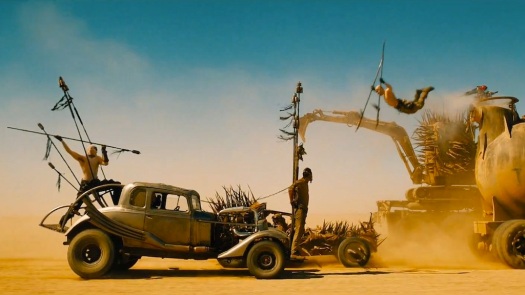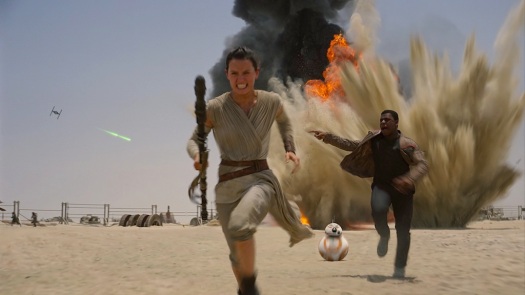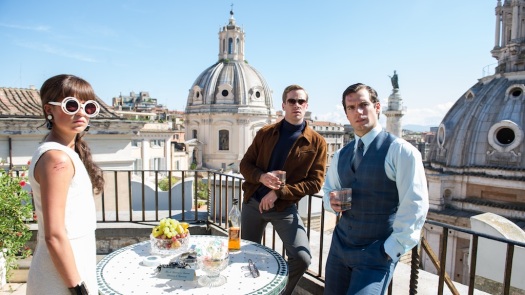 Before I saw Mad Max: Fury Road, I had only seen three George Miller movies in my life, and none of them belonged to the Mad Max series. In fact, domestic drama Lorenzo’s Oil, which features amazing performances by Susan Sarandon and Nick Nolte, it’s kind of the complete opposite of a Mad Max movie. In any case, the reasons I was unfamiliar with this franchise is the fact that Miller has spent the last ten years of his life dedicated to the dismal Happy Feet movies, the first of which inexplicably earned him an Academy Award despite being a very mediocre piece of family entertainment. The fact that his last two movies had been these penguin adventures had me very weary of the fact that, despite a pretty crazy trailer, Mad Max: Fury Road could be any good…
Before I saw Mad Max: Fury Road, I had only seen three George Miller movies in my life, and none of them belonged to the Mad Max series. In fact, domestic drama Lorenzo’s Oil, which features amazing performances by Susan Sarandon and Nick Nolte, it’s kind of the complete opposite of a Mad Max movie. In any case, the reasons I was unfamiliar with this franchise is the fact that Miller has spent the last ten years of his life dedicated to the dismal Happy Feet movies, the first of which inexplicably earned him an Academy Award despite being a very mediocre piece of family entertainment. The fact that his last two movies had been these penguin adventures had me very weary of the fact that, despite a pretty crazy trailer, Mad Max: Fury Road could be any good…
Then the reviews started coming out, and it was clear that the world -or at least the small percentage of the world that lives on the internet and obsesses over movies- had fallen in love with the fourth entry in Miller’s post-apocalyptic saga. Having seen the movie, I should have known better. This isn’t the George Miller that makes dancing cgi penguins, this is the George Miller that came with the expressionistic fantasy that is Babe: Pig in the City. The sequel to 1995’s Babe, which Miller produced, wasn’t very popular upon release, but must be revisited by any film-fan who appreciates a filmmaker with a crazy imagination.
Crazy imagination is only the appropriate way to refer to a movie like Mad Mad: Fury Road. How a movie as insane as this one got made in the first place is one of the great mysteries of our times. My guess is Miller used the fact that his movie was based on a pre-existing franchise to somehow get Warner Bros. to give him 150 million dollars to go crash cars and explode trucks in the Namibian desert. The origin might be dubious, but the result is invigorating. Mad Max doubles down on extreme weirdness, and runs over the CGI apes and comic-book properties of recent blockbusters. If this were a perfect world, Mad Max: Fury Road would usher a golden age of big-budget action filmmaking. In reality, it will probably end the weekend outgrossed by Pitch Perfect 2.
At the end of the day, it’s not a huge deal. No matter what happens in the future, we will always have this movie. But don’t just take my introductory word for it. Accepting Fury Road at face value might be fun, but what we -and action filmmakers- need to do, is understand why it is as good as it is. Well, since it seemed to work pretty well when I reviewed Age of Ultron, I’ve decided to apply the Blockbuster Method® (which is what I’ve decided to call the six-step analysis I developed to judge the merit of Hollywood blockbusters) to Mad Max: Fury Road.
The Plot
A lot of people would say there isn’t much plot to Mad Max: Fury Road. And they’re kind of right. The movie is practically made up of one long, massive chase sequence, but while the particulars of the plot are not essential to one’s enjoyment of the film, the larger ideas behind the plot had me as excited for the existence of Fury Road as its wild action sequences. Now, “larger ideas” is not something you might have expected to find in Fury Road, and to be totally honest, said ideas are not all that complex. Which doesn’t mean they’re not exciting. Because if you get right down to the core of it, Miller has made one of the most badass feminist movies I’ve ever seen.
I’ll get more into the “themes” and “representation” of the movie later in this review. Right now, let us concentrate on the practical mechanics of the plot. Turns out Max Rockatansky (Tom Hardy), although a constant and valued presence during most of the movie, isn’t really the protagonist. He is just trying to make it out of this ridiculous adventure in one piece. The real character arc belongs to Imperator Furiosa (Charlize Theron), a one-armed female warrior trying to lead a group of young concubines in an intricate plan to escape the oppressive regime that has developed in the wake of the apocalypse.
This new society is totalitarian, based on the scarcity of basic living resources and, of course, dominated by men. Most specifically, it is dominated by a grotesque warlord by the name of Immortan Joe (Hugh Keays-Byrne). The details aren’t fully explored, but from what I can infer, Joe is one of the few males that have the privilege to procreate, or at least, to engage in sexual activities indiscriminately. It’s also pretty clear that it’s really hard to bare healthy children in this dystopia. That is why Joe is particularly upset that one of the runaway concubines is pregnant with his child.
Under Joe’s rule, women, depending on their age and attractiveness, are either his concubines or used to harvest breastmilk out of their bodies. And that’s if you’re lucky. Women among the masses are just dirt poor malnourished beggars. The one exception seems to be Furiosa, the lone female that has somehow risen into the upper echelon of the warrior class. It’s understood that Furiosa has done some pretty terrible things in order to become an “Imperator”, and her escape plan to help the young maidens, is fueled by an inner search for redemption. 
The Action
But enough about the plot, let’s talk about the action! Because, let’s face it, most people will go into Mad Max: Fury Road to see some death-defying stunts and explosions. Those people will not be disappointed. Case in point, when we got out of our screening, my girlfriend told me this was the first action movie in a long time that had earned raw emotional reactions from her. This was very illuminating for me in understanding the movie’s strengths. I agree with her. I last time I felt truly exhilarated by an action movie was last year’s Snowpiercer, which shares a lot of similarities with Fury Road in the action department.
First of all, there is very little use (or at least noticeable use) of CG in the movie. You can be amazed by the sequences in Fury Road, because despite how batshit insane they are, you recognize that these are actual cars driving through the actual desert and performing actual stunts while surrounded by actual explosions. It is pure madness of a tactile variety that will actually make you feel the thrill of the chase. And the thrill of action is one of the most primal elements of cinema. It is a true illusion. It is why watching Buster Keaton driving a locomotive in The General will always be infinitely more thrilling than the CG-infused finale of any Marvel movie.
The second big aspect is in the stakes of the action. Both Fury Road and Snowpiercer can be very violent movies, but they are also movies that have a meaningful engagement with their action. Action in these movies isn’t airless and shiny as in most of Hollywood’s four-quadrant-blockbusters, even when it is overtly cartoonish and over-the-top, the violence is colored with an uncomfortable sense of dread. Missing limbs, gross scars, deformed people, they are all present to point out the nightmarish results of a system built around the exercise of violence.
And while we’re on the topic of color, we must talk about the aesthetics of the movie. Instead of the usual monochrome grey of most dystopian stories, Miller saturates his movie in a way that seems designed to parody recent action movies. You know how mainstream action movies tend to build their visual style around the juxtaposition of teal and orange? Well, Miller and cinematographer John Seale take it to the point where the color palette becomes ridiculous, with long stretches of the movie completely ignoring the rest of the color wheel. The result is not only cheeky, but highly effective. Seeing something green becomes a luxury.
As for the design elements, the movie seems deeply indebted to the spirit of the eighties, when two thirds of the original Mad Max movies were made. More specifically, though, Fury Road looks like a world designed by an eleven year-old who has just discovered crystal meth. Who else, in his right mind, would include a mutant guitarist hanging on wires and a wall of amps as part of the design of one of these battle cars? And this crazy design actually ends up being a thematic strength. It becomes part of Fury Road‘s feminist bend the moment it presents us with a group of women trying to escape the oppression of a world designed by a pubescent boy.
The Heroes
I said it before, and I’ll say it again: the star of this show is Charlize Theron’s Imperator Furiosa. Not only does she own this movie, but she is perhaps the greatest female action hero of my lifetime (for context, I was born in ’92). With Furiosa, Miller and Theron have struck a beautiful balance in terms of how the phrase “strong female character” should be understood. Furiosa is not there to serve as the initially awesome, but ultimately secondary helper to the protagonist hero (think of Trinity in The Matrix, or Wildstyle in The LEGO Movie), nor does she sacrifice emotional complexity for physical strength (it’s not he best example, but right now I can only think of Lucy).
The most pleasantly surprising thing about Furiosa, is that you can see how she has not been designed to satisfy men (as in male audiences). She has designed to be a great character. The movie might bare Max’s name, but it understands who the star of the show is. This doesn’t mean that Max is not a valuable part of the movie. In fact, Hardy’s performance as Max might be one of the best performances he has ever delivered, and a surprising one in that it reveals him as a truly gifted physical and comedic performer.
The beauty of Fury Road is that it is willing to share the wealth among its two heroes. If everyone’s talking about Furiosa coming out of the movie, it’s because her character is a unicorn; often impossible to find in mainstream entertainment, whereas we have seen a couple of Maxes before (I mean, he did headline three movies before this one). In praxis, they make a delightful duo. One of the movie’s biggest feminist statements is that Max and Furiosa are equals, as exemplified in an awesome moment when Max wants to shoot a distant enemy and hands the gun to Furiosa, knowing she will do a better job.
 The villains
The villains
But let’s talk about Fury Road‘s other, more subversive, feminist statements. Before we do, however, we will have to talk about the movie’s main villain, Immortan Joe, and how he plays into the movie’s themes. He is, after all, the man who has created this oppressive universe. And even though he derives his power from the possession of water and other resources, the real fuel of his world is testosterone. Joe’s is a deeply religious warrior society, primitively based on the idea that the strongest man must rule, and were fanaticism supplies the Immortan with an army of younger fighters willing to die for him, as expressed in their battle cry “I live, I die, I live again!”
What exactly is Miller’s critiquing through this depiction? Well, religion has been a historic oppressor of women’s rights, but I think the most important element of Miller’s critique is the dogmatic nature with which the people under Joe’s rule -especially the warriors- have bought into his discourse. These are all blood-thirsty men who have bought into Joe’s masculine ideals. He has presented them with an idea of what it means to be a man, and with a path that will let them live forever (not unlike the idea of righteous honor and legacy that fuels the military). Joe’s society is presented as oppressive and perverted, but it is closely based on some of the core ideals that men have turned into the pillars of our own.
THE representation and themes
In this case “Representation” and “Theme” go hand-in-hand, as Mad Max: Fury Road presents us with one of the most appealing and refreshing messages of any blockbuster in a long, long time. Miller presents us with a dystopian world created by the brute power of man, and argues that the way to fix such a twisted reality is to give the power to women. Very importantly, while Furiosa is the central and most powerful of the women, she is not alone in her fight. Other women fight beside her. Mad Max: Fury Road might very well be the best piece of publicity Hilary Clinton could’ve asked for.
If there is any representative element that made a little uncomfortable is the movie’s depiction of people with disabilities. If only because I am not quite sure how the movie feels about this. On the one hand (no pun intended), you have a character like Furiosa, who is a fearless military leader despite missing an arm. On the other, you have a number of characters among Joe’s allies that are presented as “deformed” (possibly inbred) grotesques. I would have to watch the movie again before making any conclusions about this aspect, but I think raising these types of flags about representation when talking about major mainstream pieces of media.
Putting that question aside, though, Mad Max: Fury Road is a fantastic and far more thoughtful experience than I was expecting from a movie about cool cars driving through the desert. It’s hard to imagine there will be a better, more exciting, and more thematically satisfying blockbuster coming out of Hollywood in the near future. And even if it never comes, we will always have Fury Road.
Grade: 9 out of 10








 Before I saw Mad Max: Fury Road, I had only seen three George Miller movies in my life, and none of them belonged to the Mad Max series. In fact, domestic drama
Before I saw Mad Max: Fury Road, I had only seen three George Miller movies in my life, and none of them belonged to the Mad Max series. In fact, domestic drama 
 The villains
The villains